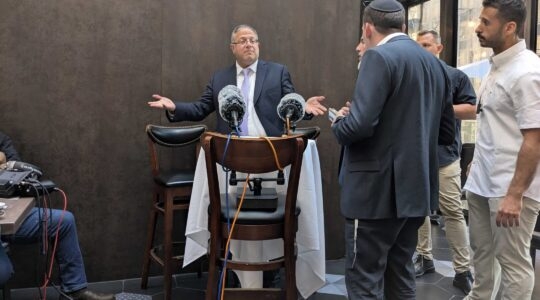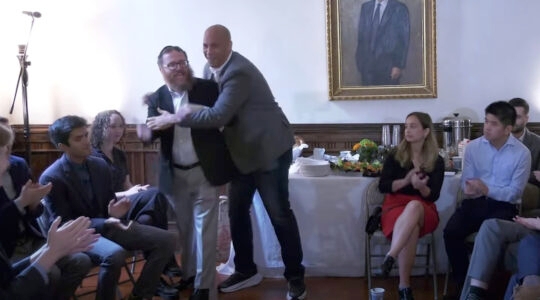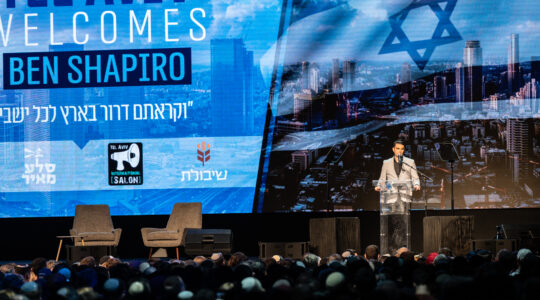JERUSALEM (JTA) – A six-month cease-fire between Israel and Hamas, due to go into effect Thursday, could help create conditions for wider peacemaking between Israel and the Palestinians.
But there are two huge potential stumbling blocks: Israeli generals doubt whether the “tahadiyeh,” or truce, will hold and the chances that Hamas and the more moderate Fatah, which controls the West Bank, will work in tandem for a wider peace deal are remote.
When Hamas violently took control of the Gaza Strip a year ago, Israeli and American leaders saw a window of opportunity for peacemaking with the relatively moderate Fatah leaders.
The idea was that with Hamas out of the way, Palestinian Authority President Mahmoud Abbas finally could negotiate the two-state deal Israel and the Palestinians have been trying to close ever since the signing of the 1993 Oslo Accords.
A year later, the situation is more complicated.
Abbas hasn’t had the authority or power to deliver on a deal that would include only the West Bank, let alone a full-fledged peace-abiding Palestinian state in the West Bank and Gaza.
After some 2,000 Kassam rockets and mortar shells blasting Israel’s southern towns, it has become clear that as long as Hamas controls Gaza, it can scuttle any deal by rocketing Israeli civilians.
Egypt announced Tuesday that the cease-fire deal it has been brokering between Israel and Hamas would go into effect Thursday morning. Israeli forces will stop initiating attacks in Gaza and Hamas will ensure an end to cross-border shelling from the territory, Egyptian mediators said.
Hamas confirmed the truce schedule. Israel said only that it was sending a senior defense official, Amos Gilad, to Cairo for a new round of talks.
Israeli officials had said earlier a truce was imminent and that in addition to a suspension of hostilities, it would involve easing a blockade on Gaza.
But Israel has demanded progress in talks on the release of Cpl. Gilad Shalit, a soldier held hostage by Hamas, for Gaza’s border crossing with Egypt to open.
For weeks, Egypt has been mediating a temporary lull in hostilities between Israel and Hamas. In a breakthrough a few days ago, both sides agreed to make major concessions. Hamas dropped its insistence on linkage between a cease-fire in Gaza and one in the West Bank, and Israel gave up its demand for Shalit’s release as part of an initial cease-fire deal.
Hamas’ compromise on the West Bank, where Israel insists on freedom of action against radical militants, constitutes a major retreat. The implication is that Hamas does not speak for the Palestinian people as a whole but only for Gaza.
Israel agreed to decouple the cease-fire and Shalit’s release on the understanding that immediately after the lull takes hold, the parties will begin intensive negotiations through Egypt on a prisoner exchange.
Although neither recognizes the other, Israel and Hamas for their own reasons have agreed to stop shooting after a year of relentless hostilities. Both sides have much to gain from the cease-fire.
Over the past few months, Hamas and other militant groups have been taking a pounding from the Israel Defense Forces, losing an average of four members a day. That pounding continued Tuesday, even as the cease-fire was announced.
Moreover, without a cease-fire, Hamas leaders know they face the prospect of a major Israeli ground incursion that could deal a crushing blow to their military infrastructure.
They also hope that if the lull holds, Israel will lift its economic blockade and open border crossing points, including the Rafah crossing into Egypt.
For Israel, a cease-fire would enable it to avoid the inevitable casualties of a major ground operation, ensure quiet for civilians in the Gaza perimeter who have been under constant rocket attack for more than seven years and create conditions for Shalit’s release.
Hamas attacks in recent weeks have become more intense after the militiamen received Iranian 120mm mortars, which are more accurate, more deadly and have a longer range than the homemade Kassam rockets they had been using.
Israel, however, does have some major concerns.
Israelis are worried that Hamas will use the lull to bring in heavy weapons, build bunkers, move up forces and lay mines close to the border fence. In short, Hamas will be able to make major strides toward what the Israelis call the “Hezbollization of Gaza” – the creation of a military infrastructure similar to that of the Iranian-backed Hezbollah in Lebanon.
They are worried as well that the Egyptians, even with special new American equipment for locating tunnels, will not prevent large-scale weapons’ smuggling into Gaza during the lull. Moreover, the Israelis are not sure that Hamas can be trusted, once the military pressure is off, to make a deal on Shalit.
The Israeli Cabinet, because of the cease-fire’s potential downside, has been divided. Defense Minister Ehud Barak resisted pressure from Kadima Party leaders – including Prime Minister Ehud Olmert and his would-be successors, Foreign Minister Tzipi Livni and Transport Minister Shaul Mofaz – to launch a major ground attack. But the real threat of a ground action may have been a factor in Hamas’ decision to support the cease-fire.
If the cease-fire does hold, it could help create the conditions for an agreement between Israel and the more moderate West Bank leadership.
The answer to Abbas’ perceived weakness has been what the parties are calling a “shelf agreement” – Israel and the moderate Palestinians, with American help, are trying to reach a deal on Israeli-Palestinian peace that remains “on the shelf” until conditions are ripe for its implementation.
This suits Israel because it shows the international community how far the Jewish state is prepared to go for a peace deal without actually having to make any concessions. And it suits the Palestinians, who intend to pocket whatever concessions Israel makes on paper as a point of departure for further gains if and when implementation becomes possible.
The more moderate West Bank Palestinians have been pressing for Israel to start putting down on paper the agreed elements of a peace agreement. U.S. Secretary of State Condoleezza Rice’s recent visit to Israel, her sixth since the Annapolis peace conference last November, was intended to help this process.
With the December target date set by President Bush for an Israeli-Palestinian agreement only six months away, the U.S. administration is urging both sides to make quicker progress. Rice seems to be rapidly approaching the point where she will prepare to start exerting pressure on both sides. This week she was highly critical of new Israeli construction projects in Jerusalem and the West Bank.
On the face of it, the cease-fire with Hamas and the new urgency on the moderate Palestinian track could pave the way for a wider Israeli-Palestinian agreement.
But Fatah and Hamas are locked in a mortal struggle for control of the Palestinian movement. The chances of them getting together and presenting the united front that would make a wider peace deal possible are remote.
JTA has documented Jewish history in real-time for over a century. Keep our journalism strong by joining us in supporting independent, award-winning reporting.





